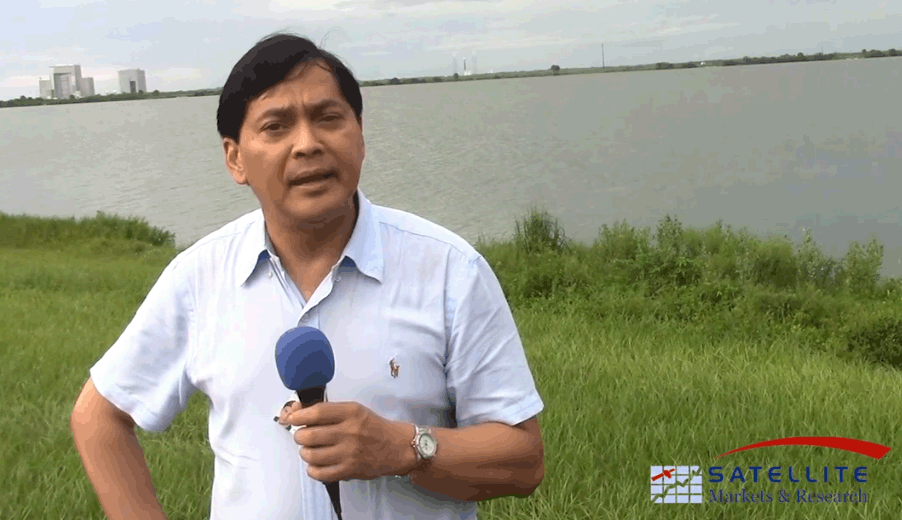A New Star Over Africa
by Virgil Labrador
Tel Aviv, Israel, November 4, 2019--On August 6, 2019, AMOS-17 was successfully launched by a SpaceX Falcon 9 rocket from Cape Canaveral, Florida. The satellite is located at 17 degrees East where it covers the African continent, along with Europe, the Middle East and Asia. It is positioned right over central Africa, to optimize service in the region.
Scheduled to be operational in November, AMOS-17 is the most advanced high-throughput satellite (HTS) to date, providing satellite communication services to Africa.
 |
| AMOS-17’s advanced digital technology provides a lot of flexibility for customers in Africa. Pictured here are the 12 high throughput C-Band beams each covering a major country in Africa. |
Manufactured by Boeing Satellite Systems International, AMOS-17 is 6.5-ton high-power, high throughput satellite designed specifically to meet Africa’s fast-growing communication demands. AMOS-17’s advanced digital payload will operate in the C, Ku and Ka bands with a digital channelizer to provide fixed HTS C-band coverage to Africa, steerable HTS Ka-band coverage to anywhere from China to Brazil, and extensive Ku-band coverage throughout Africa with additional coverage in Europe, the Middle East, China, and India.
“AMOS-17 offers a lot of flexibility for customers. It has a digital processor which allows for the interconnectivity of the various bands, for example, we can uplink in C-Band and downlink in Ku-Band,” said Jacob Keret, Senior Vice-President for Sales of Spacecom, the operator of the AMOS satellites. “The satellite also has 12 HTS C-Band beams, each covering a major country in Africa, so you don’t need to go to two or three different beams to cover one country like other HTS satellites,” Keret added. He said the high-powered C-Band beams allows for smaller dishes to downlink the signal--a key consideration for broadband and broadcast solutions for the African market.
The satellite’s digital processing capabilities provide connectivity between all of AMOS-17’s beams in all available bands in any combination. These capabilities also support suppression of interference, flexible capacity allocation, and other digital processing features for improved service. Additionally, all command and control channels, as well as telemetry, are encrypted for maximum security. AMOS-17 is planned to be in operation for a minimum of 20 years, enabling long-lasting and stable service.
“The combination of the inherent flexibility of the digital platform with the mix of fixed and steerable beams ensures fast response to changing customers’ needs,” said Keret.
With its extensive capabilities, flexibility, and reliability, AMOS-17 is poised to support growth in a variety of broadcast, broadband, mobility and data services throughout the African continent.
Spacecom CEO David Pollack said, “AMOS-17 places us directly into the exciting growth of Africa’s Sub-Saharan vibrant markets. As a leading multi-regional satellite operator, Spacecom is introducing the most technologically advanced satellite with HTS beams to service Africa where AMOS-17 will deliver a large selection of services to a variety of broadcast, broadband and telecom clients.”
Spacecom operates the AMOS-3 and AMOS-7 satellites co-located at 4°W, and AMOS-4 at 65°E, provides high-quality broadcast and communication services to Europe, the Middle East, Africa, and Asia via direct-to-home (DTH) and direct broadcast satellite (DBS) operators, Internet service providers (ISPs), telecom operators, network integrators and government agencies.
“The AMOS-17 satellite will provide a great fit for Spacecom’s expansion strategy, offering an innovative design with capabilities that provide flexible service offerings to meet the growing demands of our customers,” said Keret.

To view a video of the coverage of the satellite launch with Satellite Markets and Research Editor-in-Chief Virgil Labrador , click here
----------------------------------
 Virgil Labrador is the Editor-in-Chief of Los Angeles, California-based Satellite Markets and Research which publishes a web portal on the satellite industry www.satellitemarkets.com, the monthly Satellite Executive Briefing magazine and occasional industry reports called MarketBriefs. Virgil is one of the few trade journalists who has a proven track record working in the commercial satellite industry. He worked as a senior executive for a teleport in Singapore, the Asia Broadcast Center, then-owned by the US broadcasting company CBS. He has co-authored two books on the history of satellite communications and satellite technology. He holds a Master’s in Communications Management from the University of Southern California (USC). He can be reached at virgil@satellitemarkets.com
Virgil Labrador is the Editor-in-Chief of Los Angeles, California-based Satellite Markets and Research which publishes a web portal on the satellite industry www.satellitemarkets.com, the monthly Satellite Executive Briefing magazine and occasional industry reports called MarketBriefs. Virgil is one of the few trade journalists who has a proven track record working in the commercial satellite industry. He worked as a senior executive for a teleport in Singapore, the Asia Broadcast Center, then-owned by the US broadcasting company CBS. He has co-authored two books on the history of satellite communications and satellite technology. He holds a Master’s in Communications Management from the University of Southern California (USC). He can be reached at virgil@satellitemarkets.com





